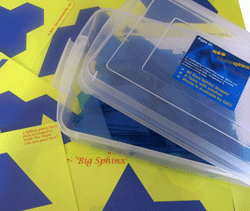The Sphinx sits on top of an iceberg of investigations related to mathematical language, shape and space, tessellations, area, perimeter, patterns, powers, mathematical proof, similar shapes and who knows what else is yet to be discovered.
Until now, teachers and students had to print the shapes from the web, make multiple copies, laminate and then cut out the shapes one by one! But now strong, colourful plastic shapes are economically available.
Includes 80 crystal blue pieces + 8 double-sided plastic activity cards & instructions.
Comes in a handy storage box with clip-on lid.
Teaching TILINGS / TESSELLATIONS with Geo Sphinx
Grunbaum and Shephard defined TILINGS /TESSELLATIONS in 1987 as "partitionings of the plane into regions, or tiles".
Most students will easily recognise that any regular triangle, quadrilateral, and hexagon can tile a plane surface. However, to determine whether any shape different from the above-mentioned will cover the plane without gaps or overlaps can be a far more challenging task. The SPHINX SHAPE provides a perfect extension activity for tessellation lessons. It is made up of 6 equilateral triangles as shown in the diagram on the left.
Geo Sphinx and REP-TILES
A rep-tile is a geometric shape which can be fitted together with copies (replicas) of itself to form a larger similar figure.
A simple example of rep-tile is the square: 4 congruent squares will build a larger square; with 4 of these large squares an even larger square can be made etc. By continuing this activity many times, the plane will be tiled. Therefore, we can say that the square is a rep-4 tile. So is the Sphinx. In fact, with 4 Sphinx shapes, a bigger Sphinx can be formed. A curious fact is that every rep-4 tile is also a rep-9 tile (see diagrams below).

^ Sphinx as a Rep-4

^ Sphinx as a Rep-9
Rep-tiles help students to acquire spatial sense and to visualise and represent geometric figures as well as to explore their transformations. Creating a tiling pattern requires such mental imagery as visualising the possible rotations and placements of a tile in the tiling pattern, thus further developing spatial awareness.
Activities using Geo Sphinx
Ask students to form a Sphinx from 4 pieces. This is called a rep-4 size 1 Sphinx. Ask them to work out what size 2 would be (4x4=16). Ask groups of 4 to build it. Solution: see diagram on the left.
Now let them calculate how many Sphinxes are needed for a rep-4 size 3 (4x4x4=64) and have them build it. Encourage them to verbalise and record a rule which allows to determine the number of Geo Sphinx shapes necessary to make ANY SIZE rep-4 sphinx.
Solution
Rep-4 Sphinx size n = 4 x 4n-1 = 4 n

^ Sphinx as a Rep-4 (size 2)
The experiment can be repeated with the Sphinx as a rep-9 tile. Size 2 requires 81 Geo Sphinx pieces (see diagram left). Size 3 requires 729 Geo Sphinx pieces. In this case, the summarising rule to determine the number of Geo Sphinx shapes necessary to make ANY SIZE rep-9 Sphinx is:
Rep-9 Sphinx size n = 9 x 9n-1 = 9 n

^ Sphinx as a Rep-9 (size 2)
More Sphinx Ideas
A different way of looking at the size of a Sphinx is to consider the pieces at its base. Assuming that the longest side of a Geo Sphinx piece has the value 1, the other sides will be worth 2/3 and 1/3. This way, the Sphinx also provides an interesting cue for fractions activities. Here are some examples of how we can calculate the size of a Sphinx following the above method.
Any Sphinx is always made up of as many pieces as the square of its size (base length).

^ Size 2, 4 pieces

^ Size 4,16 pieces

^ Size 3, 9 pieces. Base: 2/3 + 1 + 1 + 1/3 = 3

^ Size 6, 36 pieces. Base: 1/3+1+1+1/2+1/3+1+1+1/2= 6
We made a size 2 & a size 3 Sphinx. Is it possible to build a Sphinx which has ANY PRIME NUMBER as its base length??
Geo Sphinx as a puzzle game
At the end of the lesson, the Sphinx can be made into an entertaining challenge by asking the children to guess how 4 pieces were joined to make outlines such as the ones on this Task Page.
You can then ask pupils to think of what outlines THEY could make with 5 or 6 pieces.
To find out even more about the sphinx problem go to: www.mathematicscentre.com/taskcentre/icesphinx.htm




